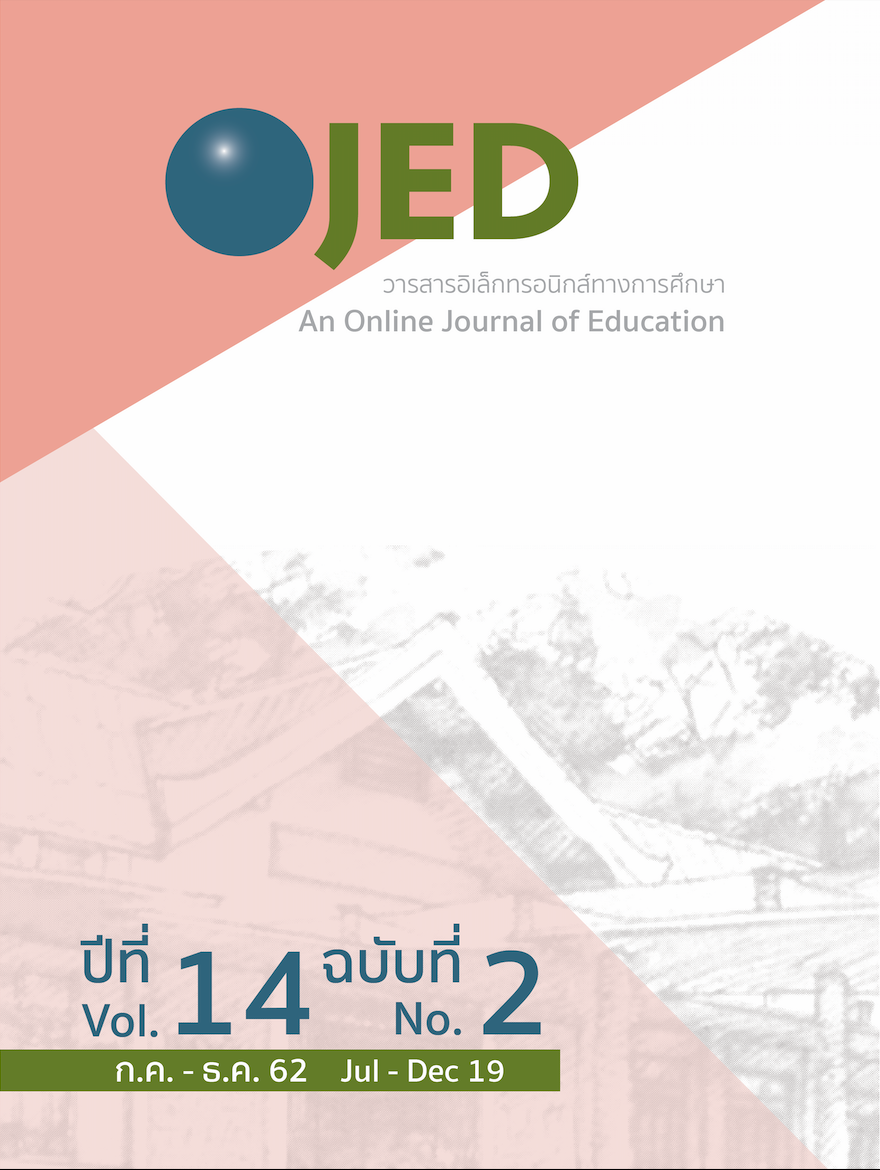แนวโน้มความเหลื่อมล้ำทางการศึกษาในโรงเรียน สังกัดสำนักงานเขตพื้นที่การศึกษามัธยมศึกษา กรุงเทพมหานคร
DOI:
https://doi.org/10.14456/ojed.2019.57Keywords:
ความเหลื่อมล้ำทางการศึกษา, การวิเคราะห์กลุ่มแฝง, ภูมิหลังทางด้านเศรษฐกิจและสังคม, ผลสัมฤทธิ์ทางการเรียนAbstract
This study aimed to compare the economic and social background of students with regards to parents’ income, types of residences, family status, and household residents. This research collects data from secondary sources using O-NET examiners' database. Individuals, grade 3, studying in schools under the Basic Education Commission (OBEC), academic year 2017 Of the National Institute of Educational Testing Service. The target group of this study was 11,534 secondary school students in schools under the Secondary Educational Service Area Office 2. The data were analyzed using latent class analysis with R Programming.
The findings can be summarized as follows:
(1) Based on their economic and social backgrounds, students in schools under the Secondary Educational Service Area Offices in Bangkok can be classified into 3 classes (Likelihood = 25.82, df = 1, ACI = 42,402.72, BIC = 42,505.67, Adjusted BIC = 42,380.90, and Entropy = 0.81): Class 1 Students from warm families with good economic status (23.95%), Class 2 Students from warm families with poor economic status (50.06%), and Class 3 Students from incomplete families with poor economic status (25.99%).
(2) Regarding the educational inequality of students in schools under the supervision of the Office of Basic Education Commission in the metropolis, there was no significant difference between the O-NET (Ordinary National Educational Test) average scores of Thai, English, Mathematics and Science of the three classes of economic and social backgrounds. ( = 0.02 )
คำสำคัญ: ความเหลื่อมล้ำทางการศึกษา / การวิเคราะห์กลุ่มแฝง
KEYWORDS: EDUCATIONAL INEQUALITY/ LATENT CLASS ANALYSIS
References
กองทุนเพื่อความเสมอภาคทางการศึกษา. (2561). พระราชบัญญัติ กองทุนเพื่อความเสมอภาคทางการศึกษา. สืบค้นจาก https://www.ratchakitcha.soc.go.th/DATA/PDF/2561/A/033/1.PDF
คณะกรรมการการศึกษาขั้นพื้นฐาน. (2553). พระราชบัญญัติการศึกษาแห่งชาติ พ.ศ. 2542 แก้ไขเพิ่มเติม (ฉบับที่ ๒) พ.ศ. ๒๕๔๕ และ (ฉบับที่ ๓) พ.ศ. ๒๕๕๓. กรุงเทพมหานคร: สำนักงานคณะกรรมการ การศึกษาแห่งชาติ.
พิมพ์ชนก กลิ่นสุทโธ. (2554). การศึกษาอัตลักษณ์แห่งตนของวัยรุ่นที่ครอบครัวแตกแยก (วิทยานิพนธ์ปริญญามหาบัณฑิต ). มหาวิทยาลัยศรีนครินทรวิโรฒ, กรุงเทพมหานคร.
สำนักงานคณะกรรมการพัฒนาการเศรษฐกิจและสังคมแห่งชาติ. (2559). รายงานการวิเคราะห์สถานการณ์ความยากจน และความเหลื่อมล้ำในประเทศไทย ปี 2559. สืบค้นจาก https://social.nesdb.go.th/social/Po
rtals/0/PDF%20รายงานความยากจนฯ%202559.pdf
สำนักงานสถิติแห่งชาติ. (2560). สรุปผลที่สำคัญการสำรวจภาวะเศรษฐกิจและสังคมของครัวเรือนในช่วง 6 เดือนแรก ของปี 2560. สืบค้นจาก https://www.nso.go.th/sites/2014/DocLib13ด้านสังคม/สาขารายได้/เศรษฐกิจสังคมครัวเรือน/60/SocioSum60_First-6-Month.pdf
สำนักยุทธศาสตร์และประเมินผล. (2559). สถิติ 2559 กรุงเทพมหานคร. สืบค้นจาก https://203.155.220.230/bmainfo/docs/statisticbook/stat_2559_thai.pdf?fbclid=IwAR1iiu_TFxPTVlkKz3k9yiLfobDPVOrlR2h9zazdrUyTOL9a2glzpSIbOdg
สุธิดา ภักดีบุญ. (2548). การวิจัยพหุเทศะกรณีศึกษาของระบบการดำเนินงานการดูแลช่วยเหลือนักเรียนในสถานศึกษา (วิทยานิพนธ์ปริญญามหาบัณฑิต). จุฬาลงกรณ์มหาวิทยาลัย, กรุงเทพมหานคร.
Connelly, R., Gayle, V., & Lambert, P. S. (2016). A Review of occupation-based social classifications for social survey research. Methodological Innovations, 9. doi:10.1177/2059799116638
003
McKay, A. (2002). Defining and measuring Inequality. Briefing Paper, 1, 1-6.
Münich, D., Plug, E., Psacharopoulos, G., & Schlotter, M. (2012). Equity in and through education and training: Indicators and priorities. Retrieved from www.eenee.de/dms/EENEE/Ana
lytical_Reports/EENEE_AR12.pdf
Organisation for Economic Co-operation and Development. (2018). Education at a glance 2018. Paris: OECD Indicators, OECD Publishing doi:10.1787/eag-2018-en.
Owens, A. (2017). Income segregation between school districts and inequality in students’ achievement. Sociology of Education, 91(1), 1-27. doi:10.1177/0038040717741180
Downloads
Published
How to Cite
Issue
Section
License
Copyright (c) 2019 An Online Journal of Education

This work is licensed under a Creative Commons Attribution-NonCommercial-NoDerivatives 4.0 International License.




